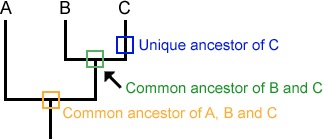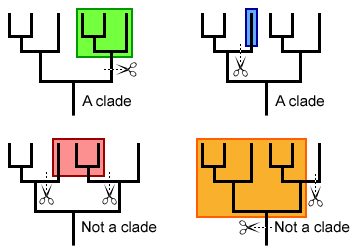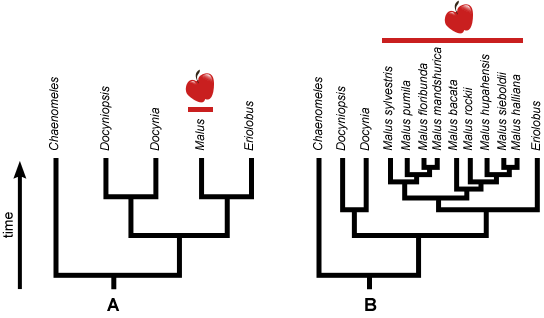 Last month, I proudly introduced you to NOVA’s new Evolution Lab. As part of my review, I talked about how wonderful the Build a Tree feature is because a) it lets you be wrong and b) because there is no one way to construct the tree—outgroups don’t have to be on the left, for example. The other part of the Lab, the super swooshy and impressive Deep Tree, is dazzling, but the amazing John Harshman has found some things that need to be fixed (it appears that the Deep Tree relied on some out-of-date data, for example). The result was a lot of back and forth with Harshman as I tried to understand the issues well enough to relay them to NOVA (who then relayed them to the experts at Harvard who collaborated on the Deep Tree). I am not a phylogeneticist (Harshman is) so this took some doing. Also somewhere in there, I was editing an assessment and wrote a tree-interpretation question for a client along the lines of: Which group on the tree is most closely related to group X? The person to whom I sent it for review—a PhD biologist—got the answer wrong.
Last month, I proudly introduced you to NOVA’s new Evolution Lab. As part of my review, I talked about how wonderful the Build a Tree feature is because a) it lets you be wrong and b) because there is no one way to construct the tree—outgroups don’t have to be on the left, for example. The other part of the Lab, the super swooshy and impressive Deep Tree, is dazzling, but the amazing John Harshman has found some things that need to be fixed (it appears that the Deep Tree relied on some out-of-date data, for example). The result was a lot of back and forth with Harshman as I tried to understand the issues well enough to relay them to NOVA (who then relayed them to the experts at Harvard who collaborated on the Deep Tree). I am not a phylogeneticist (Harshman is) so this took some doing. Also somewhere in there, I was editing an assessment and wrote a tree-interpretation question for a client along the lines of: Which group on the tree is most closely related to group X? The person to whom I sent it for review—a PhD biologist—got the answer wrong.
 Why am I telling you all of this? Because evolutionary trees are everywhere—in textbooks, museums, trade books, and journals and magazines—and they are key to understanding common descent. And yet, to interpret them properly, you need to understand some specialized vocabulary and to adopt a specific mindset. Unfortunately, It’s tough to talk tree. So I figured that we could go on a tree exploration here by touching upon some common misconceptions. Hold onto your hats; this will be a multi-parter.
Why am I telling you all of this? Because evolutionary trees are everywhere—in textbooks, museums, trade books, and journals and magazines—and they are key to understanding common descent. And yet, to interpret them properly, you need to understand some specialized vocabulary and to adopt a specific mindset. Unfortunately, It’s tough to talk tree. So I figured that we could go on a tree exploration here by touching upon some common misconceptions. Hold onto your hats; this will be a multi-parter.
But before we even get to the misconceptions, we need to establish some basics and learn some vocabulary. In any evolutionary tree, the leaves at the end of the branches represent taxa (the singular is taxon)—which are most commonly species (e.g., Homo sapiens) or groups of species (e.g., all hominins). Places  where two branches meet are called nodes. Nodes represent common ancestors of the branching lineages. A lineage, or phylogeny, is the evolutionary history of a particular group. Trace a path from a taxon to a common ancestor and you have a lineage.
where two branches meet are called nodes. Nodes represent common ancestors of the branching lineages. A lineage, or phylogeny, is the evolutionary history of a particular group. Trace a path from a taxon to a common ancestor and you have a lineage.
Evolutionary trees can be rooted or not. A rooted tree has a unique node corresponding to the most recent ancestor of all the taxa present; an unrooted tree—unsurprisingly—doesn’t. Rooted trees are often rooted by outgroups. An outgroup is a taxon closely related to the clade you’re interested in but more distantly related than anything else in the tree is to each other. So, for example, if you’re putting together a tree of bird species, your outgroup might be something like a dromaeosaur—not a bird, but a member of a closely related group. The root of your tree will then be the most recent common ancestor, whatever it is, of the dromaeosaur and the rest of the taxa. The point of the root is to establish a basis for comparison and to define the boundaries of the group being modeled.
And finally, a clade, or monophyletic group if you’re feeling fancy, is a group that contains an ancestor and all of its descendants. When looking at a tree, imagine that you have some big pruning shears—everything that falls off the tree with a snip through only one branch is a clade. If you have to make two snips to get a group free, it isn’t a clade.

This is a good time to explain the main difference between classic Linnaean classification and evolutionary classification (or cladistics). In evolutionary classification, names are only given to clades. Everyone likes the group name “birds”—it is the common name for a nice, neat Linnaean class (Aves) as well as a nice, neat clade (Avialae). But “dinosaurs” is more problematic. Under classic Linnaean taxonomy, Dinosauria was a class just like Aves—but an evolutionary biologist does not accept the group name unless it also includes birds. Why? Because dinosaurs-without-birds is not a valid clade—it would take two snips to get that grouping free (as in the orange example in the diagram). It doesn’t mean that evolutionary taxonomists don’t think dinosaurs exist—it’s just that they want birds to be recognized as, and called, dinosaurs. (Hint, hint, NHM London.)
Now I’m the first to admit that naming groups ties people in knots. Frankly, it’s a pain, and as Linnaean taxonomy tries to back itself into a more cladistic hierarchy, every single clade needs a taxonomic level and name, so we get all kinds of ridiculousness like sub-sub-families, infraorders, and supercohorts, with bizarre names like Dinosauriformes and Ornithomimosauria. It also opens us up to forever shifting group names based on esoteric arguments that totally drive me bonkers. Needless to say, I won’t be dwelling on names a lot here. I can’t be bothered.
Anyway. Where was I?
Right, the basics. Goodness, we’re still on the basics? Okay, the last thing that it’s important for you to know before we get into the misconceptions: trees are models. They represent working hypotheses about relationships in nature. When building the model, the tree-maker can do all kinds of things to emphasize what she/he wants—but that doesn’t change the information behind the model. A fairly complicated branching tree showing all the species within the apple genus Malus, for example, might be completely collapsed into a single twig labeled “Malus” in another tree. This has no bearing on the actual diversity of real apple trees. Some trees show extinct organisms, others do not—that has no bearing on whether the extinct organisms existed or how they are related to their living descendants.
This is an important thing to keep in mind when evaluating claims such as, “this discovery will redraw the tree of life!” Most of the time (though admittedly, not all the time) what the scientist/journalist really means is, “This discovery will slightly modify a tiny twiglet of the tree of this particular clade but have no bearing whatsoever on the general outline of the tree of all life.” I guess the latter isn’t as catchy headline-wise.
Okay! I think we’re finally ready to get to our first misconception…next week.
It’ll be good, though, I promise.
In the meantime, tell me your favorite clade names in the comments. How about Opisthokonta? Lophotrochozoa? Aspidogastridae? I’m not making these names up, people!
All images, except the Build-a-Tree animation are credit University of California Museum of Paleontology's Understanding Evolution (http://evolution.berkeley.edu).
Are you a teacher and want to tell us about an amazing free resource? Do you have an idea for a future Misconception Monday or other post? See some good or bad examples of science communication lately? Drop me an email or shoot me a tweet @keeps3.

